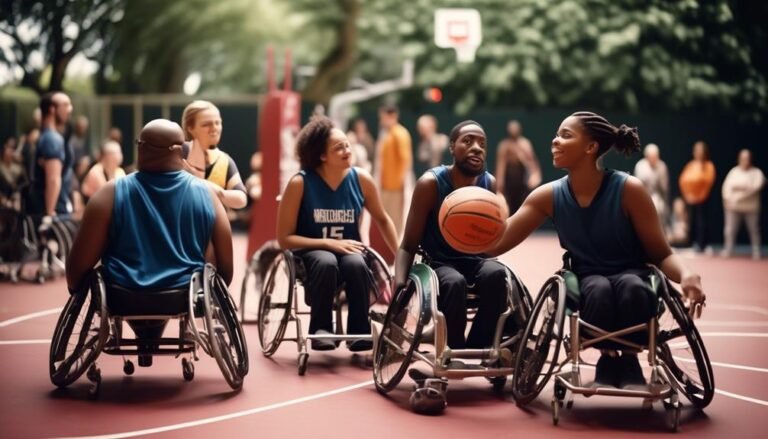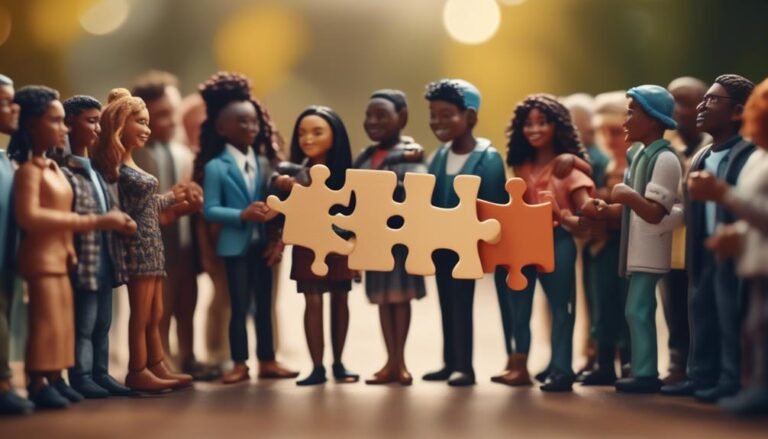Navigating Language and Communication Barriers
In today's interconnected world, language and communication barriers can present significant challenges in various settings, from the workplace to personal relationships. The ability to navigate these barriers is crucial for effective communication and fostering understanding between individuals from different linguistic and cultural backgrounds.
By recognizing the impact of language barriers, understanding cultural differences, and employing strategies to overcome limited language proficiency, individuals can bridge the gap and establish meaningful connections.
In this discussion, we will explore the importance of effective nonverbal communication, improving listening skills, and building empathy to navigate these barriers successfully.
Furthermore, we will delve into the use of technology as a tool for communication and strategies for collaborative problem-solving.
Key Takeaways
- Language barriers can hinder understanding and collaboration in various settings, such as business and healthcare.
- Professional interpreters and translation services are crucial in overcoming language obstacles.
- Cultural competence and understanding cultural differences are essential for effective communication.
- Technology, such as translation tools and video conferencing platforms, can help bridge language gaps in the globalized world.
The Impact of Language Barriers
Language barriers can have a significant impact on communication, creating obstacles that hinder effective understanding and collaboration. The consequences of language barriers are particularly apparent in the business and healthcare sectors.
In the business world, language barriers can impede international trade and limit opportunities for global expansion. Companies that fail to bridge these gaps may struggle to communicate with foreign clients, resulting in lost business opportunities. Effective communication is crucial for establishing trust and building successful business relationships, and language barriers can undermine these efforts.
In the healthcare industry, language barriers can have even more serious consequences. Patients with limited English proficiency may struggle to communicate their symptoms, medical history, or concerns to healthcare providers. This can lead to misdiagnosis, inappropriate treatment, and compromised patient safety. Additionally, language barriers can hinder effective communication between healthcare professionals, leading to misunderstandings and errors in patient care.
Addressing language barriers in both business and healthcare is essential. Employing professional interpreters or utilizing translation services can help overcome language obstacles and improve communication. Furthermore, providing cultural competency training for employees can foster understanding and sensitivity towards diverse language backgrounds.
Understanding Cultural Differences
Understanding cultural differences is crucial for effective communication and collaboration in diverse settings. Cultural customs play a significant role in shaping people's behavior, beliefs, and values. When individuals from different cultural backgrounds come together, their unique customs and traditions can impact how they communicate and interact with one another.
Intercultural communication involves understanding and appreciating these cultural differences to foster effective communication. It requires individuals to be open-minded, empathetic, and willing to adapt their communication styles to accommodate others. By recognizing and respecting cultural customs, individuals can avoid misunderstandings, misinterpretations, and potential conflicts that may arise due to cultural differences.
Cultural customs encompass various aspects, such as greetings, body language, personal space, and gender roles. For example, in some cultures, it is customary to greet others with a handshake, while in others, a bow or a hug may be more appropriate. Understanding these nuances is essential in building rapport and establishing trust with individuals from different cultural backgrounds.
Intercultural communication also involves being aware of cultural taboos and sensitivities. Certain topics or gestures that are considered acceptable in one culture may be offensive or disrespectful in another. By educating themselves about different cultural customs, individuals can adapt their communication style and show respect for others' beliefs and values.
Overcoming Limited Language Proficiency
To effectively overcome limited language proficiency, individuals must employ strategies to improve their communication skills and bridge the language gap. Here are four key techniques for improving fluency and language learning:
- Immersion: Immerse yourself in the language as much as possible. Surround yourself with native speakers, listen to podcasts or watch movies in the target language, and practice speaking regularly. This exposure helps you become familiar with the language's nuances, accents, and vocabulary.
- Language Exchange: Find language exchange partners who are fluent in the language you want to learn. This allows you to practice speaking and listening with a native speaker while helping them learn your language. Language exchange can be done through online platforms or local language exchange meetups.
- Use Language Learning Apps: Utilize language learning apps and online resources that provide interactive exercises, vocabulary drills, and pronunciation practice. These apps often have features that allow you to track your progress and provide personalized feedback.
- Take Language Classes: Enroll in language classes or hire a language tutor. Formal instruction can provide structure and guidance, as well as opportunities for speaking and practicing with other learners.
Using Technology for Communication
In today's digital age, technology plays a vital role in facilitating effective communication despite language barriers. With the help of various technology solutions, individuals can now communicate virtually, transcending language limitations and enabling meaningful interactions.
One prominent example is the use of translation tools and apps, which can instantly convert text or speech from one language to another. These tools employ advanced algorithms and artificial intelligence to accurately translate languages in real-time, making it easier for people to understand and respond to each other.
Additionally, video conferencing platforms have become increasingly popular for virtual communication, allowing individuals from different language backgrounds to engage in face-to-face conversations. These platforms often offer features like real-time transcription and translation, further enhancing the ability to communicate effectively.
Furthermore, social media platforms and messaging apps have integrated language translation features, enabling users to communicate with people who speak different languages.
In essence, technology has revolutionized communication by providing innovative solutions that bridge language gaps and foster understanding in the globalized world we live in today.
Effective Nonverbal Communication
Effective nonverbal communication plays a crucial role in conveying messages and understanding others. Body language cues, such as posture and gestures, can communicate a person's confidence, interest, or discomfort.
Facial expressions, such as smiling or frowning, can convey emotions and contribute to effective communication.
Body Language Cues
What are the key nonverbal cues that contribute to effective communication?
- Facial expressions: The interpretation of facial expressions plays a crucial role in understanding emotions and intentions. Smiles, frowns, raised eyebrows, and eye contact can convey a range of meanings.
- Gestures: Hand movements, pointing, and body postures can enhance or reinforce verbal messages. They can also indicate interest, agreement, or disagreement.
- Posture and body orientation: How we position our body and align ourselves with others can signal attentiveness, openness, or defensiveness. Leaning in can demonstrate engagement, while turning away can indicate disinterest.
- Tone of voice: The way we speak, including volume, pitch, and rhythm, can convey emotions and attitudes. A calm and steady tone can indicate confidence, while a raised or shaky voice may suggest nervousness or uncertainty.
Understanding and interpreting these nonverbal cues is essential for effective communication. They provide additional layers of meaning that can enhance or contradict verbal messages, ultimately contributing to a more comprehensive understanding between individuals.
Facial Expressions
Facial expressions play a crucial role in nonverbal communication, conveying a wide range of emotions and intentions. Our faces are incredibly expressive, allowing us to communicate without words. From a smile to show happiness, to a furrowed brow to express concern, facial expressions provide important nonverbal cues that can enhance or even contradict our verbal communication.
Various muscles in the face work together to create different expressions, such as raising eyebrows to show surprise or narrowing eyes to convey suspicion. These expressions are universally recognized, transcending language and cultural barriers. However, it is important to note that the interpretation of facial expressions can vary across cultures, so it is essential to consider cultural context when interpreting nonverbal cues.
Mastering the art of reading and using facial expressions can greatly enhance our ability to communicate effectively.
Improving Listening Skills
Improving listening skills is essential for effective communication, especially when faced with language barriers.
Active listening techniques such as maintaining eye contact, nodding, and paraphrasing can help overcome these barriers and ensure understanding.
Active Listening Techniques
Effective communication starts with active listening techniques, which enhance listening skills and promote understanding between individuals. Here are four key strategies to improve listening skills:
- Pay Attention: Focus on the speaker, avoid distractions, and maintain eye contact. Actively engage by nodding and using verbal cues to show interest.
- Avoid Interrupting: Allow the speaker to finish their thoughts before responding. Interrupting can disrupt the flow of conversation and hinder understanding.
- Practice Reflective Listening: Repeat or rephrase what the speaker has said to ensure comprehension. This demonstrates that you are actively listening and validates the speaker's thoughts and feelings.
- Ask Clarifying Questions: If something is unclear, ask for clarification. This shows your interest in understanding and helps prevent misunderstandings.
Overcoming Language Barriers
To overcome language barriers and improve listening skills, individuals must employ effective techniques to enhance their understanding and communication abilities.
One important aspect is the use of translation services, which can bridge the gap between different languages and facilitate effective communication. Translation services play a crucial role in ensuring accurate and clear understanding between parties who do not share a common language.
Additionally, effective communication strategies can greatly aid in overcoming language barriers. These strategies include active listening, asking clarifying questions, using visual aids, and practicing patience and empathy.
Building Empathy and Cultural Sensitivity
Developing a deep understanding and appreciation for different cultures is essential in fostering empathy and cultural sensitivity. Building relationships and engaging in effective cross-cultural communication are key aspects of this process.
Here are four important ways to build empathy and cultural sensitivity:
- Educate yourself: Take the time to learn about different cultures, their customs, traditions, and values. This will help you develop a better understanding and appreciation for their perspectives.
- Practice active listening: When engaging in cross-cultural communication, listen attentively and with an open mind. Avoid making assumptions or judgments based on your own cultural background.
- Be open-minded and flexible: Embrace different ways of thinking and doing things. Recognize that there is no one 'right' way and be willing to adapt your communication style to accommodate cultural differences.
- Seek opportunities for cultural immersion: Actively seek out opportunities to immerse yourself in different cultures, whether through travel, attending cultural events, or engaging in cultural exchange programs. This firsthand experience will deepen your understanding and empathy.
Strategies for Collaborative Problem-Solving
Building upon the foundation of empathy and cultural sensitivity, effective strategies for collaborative problem-solving can be implemented to overcome language and communication barriers. These strategies focus on creating an environment of open communication, fostering mutual understanding, and utilizing various problem-solving techniques.
One strategy is to encourage active listening and clarification. This involves giving full attention to the speaker, seeking clarification when necessary, and paraphrasing to ensure understanding. Additionally, using visual aids or gestures can enhance comprehension and facilitate communication.
Another strategy is to promote teamwork and cooperation. This can be achieved through team-building exercises, trust-building activities, and fostering a supportive and inclusive team culture. By working together, individuals can leverage their diverse perspectives and skills to solve problems collaboratively.
Furthermore, using technology can be an effective strategy in overcoming language barriers. Utilizing translation tools, online collaboration platforms, and video conferencing can facilitate communication and enhance understanding among team members.
Lastly, it is important to be patient and flexible when facing language and communication barriers. Recognizing that it may take more time and effort to reach a resolution, allowing for multiple perspectives, and adapting problem-solving techniques to accommodate different communication styles can help overcome these challenges.
By implementing these strategies for collaboration and problem-solving, individuals can bridge the gap created by language and communication barriers, leading to more effective and successful outcomes.
| Strategies for Collaborative Problem-Solving |
|---|
| Encourage active listening and clarification |
| Promote teamwork and cooperation |
| Utilize technology |
| Be patient and flexible |
Conclusion
In navigating language and communication barriers, understanding cultural differences and using technology for communication are crucial. By improving listening skills, building empathy, and practicing effective nonverbal communication, individuals can overcome limited language proficiency.
Ultimately, strategies for collaborative problem-solving can lead to successful communication across language barriers. Language barriers may seem insurmountable, but with the right tools and mindset, they can be overcome, fostering understanding and connection among diverse individuals.







